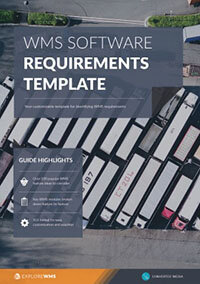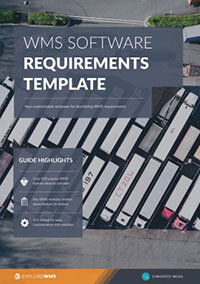The impact of WMS feature requirements on vendor shortlisting
We’ve identified more than 120 WMS features that can be found in multiple software packages, and while it’s a helpful list, that can get a little daunting. So, if you’re trying to figure out how to start WMS vendor shortlisting while also narrowing down your list, we’ve got a few thoughts for your selection team.
How do requirements impact shortlisting?
Warehouse management software can help run a wide range of tasks, some of which you might not want or need software to address. Other WMS features are going to be elements you need for the system to generate a positive ROI and ensure that management doesn’t boot you out the door.
Figuring out where each feature falls is your best bet to maximizing WMS returns and having a system your team wants to use to make daily operations better. So, we suggest you run through the features list and put each into one of four buckets: don’t need at all, must-have, would be nice-to-have, and extras you might want in the future.
Shortlisting based on all must-have requirements
Your warehouse needs a baseline set of features and functionality to make a WMS a worthwhile investment. The most common features on a must-have list include inventory management, receiving, fulfillment, and related metrics tracking. Listing yours out is the best way to start WMS vendor shortlisting because anyone who doesn’t meet this basic list should fly off the list.
Trying to figure out how to ensure you’ve got the right elements on the must-have list? Check out these three methods that help you determine what your entire operations need most.
Nice-to-haves
Beyond core functionality, warehouse management systems can perform a variety of tasks that will benefit your business. Look at all of the areas where you operate and functionality you have, and then start browsing WMS features lists to see where the platform might help.
Depending on your size and layout, these functions might include supporting inventory and fulfillment across multiple warehouses, yard management, kitting, support for adding and changing SKUs regularly, or even flexibility to support high-volume returns at different parts of the year.
Getting a good mix of nice-to-haves with your full set of must-haves is a smart way to help your company meet its Goldilocks goal.
Vendors with lots of added extras
WMS features and functions can sound amazing but not needed today, such as support for fully autonomous vehicles and carts. When you think about your business in five or ten years, what do you imagine that you’ll need?
Add these items to your WMS functionality checklist at the end and see if your vendor shortlist supports these or plans to build out the functionality before you need it. Advanced features and benefits can be an excellent tool for companies to narrow down the shortlist, especially when you’re comparing like-to-like systems.
Refining your shortlist
Creating your WMS features list gives you a reliable metric to compare vendors and see who has the features that you need. You can compare vendors against the file and then against each other all within the same document, helping you prioritize features and then rank vendors accordingly.
Cut when prices are too high, feature sets are too low, or the service is terrible — if they aren’t helpful when you’re looking to spend money, they’ll be less useful when a problem in your system costs them money.
Finally, take your feature list to your shortlist and ask to see the highlights in a demo, and turn your homework into a solid action plan.
Free white paper

WMS requirements template
Over 120 WMS feature ideas to help you build a requirements list and shortlist vendors

Featured white papers
-

WMS requirements template
Over 120 WMS feature ideas to help you build a requirements list and shortlist vendors
Download
Related articles
-

Your complete WMS features and requirements guide
How to gather requirements for a new WMS, and features to look for to meet them
-

Mission-critical features of food lot traceability software
What features of food traceability software will help you during a food recall
-

Here's your complete WMS modules and features checklist
All the features and modules you might need in your WMS - perfect for requirements gathering

